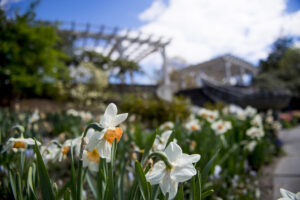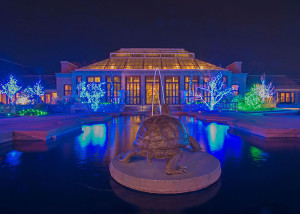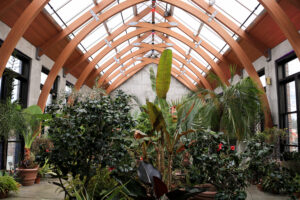By David Wilkening, Contributing Writer

Photo/Courtesy of Tower Hill Botanic Garden
BOYLSTON – There are many ways to escape colder weather but here’s one that is probably unexpected: A visit to a botanical garden. It’s open daily, year-round. It’s less than an hour’s drive from Boston, has comfortable indoor alternatives, and caters to older visitors.
Accessibility a focus
“We have always been trying to make us more accessible for everyone of all ages including seniors,” said Grace Chapman Elton, chief executive officer of Tower Hill Botanic Garden, which since 1986 has been a visitor-friendly Worcester-area institution.
Among those improvements in recent times to make the garden easier to navigate are the walk-in paths modified for visitors with mobility issues. Areas were also created to allow visitors to move slowly at their own pace. The ADA-compliant paths also made it all feel natural and a part of the landscape.
The 171-acre garden admittedly gets more visitors in temperate times, weatherwise. But that does not deter others from seeing the increasingly popular attraction during the colder months.
In fact, the most recent count of annual guests before the pandemic was 167,000. That number compares to 2012 when there were 83,072 visitors to the garden, which is about 40 miles from Boston and eight miles north of Worcester. It is regularly rated among the best attractions in the greater Boston area.
Visitors often come to see thousands of “quite beautiful tropical plants year-round,” said Elton. In the winter, it is common to find them traversing the garden’s two miles of walking trails on snowshoes and skis. “It’s a comfortable walking loop and you can stop along the way for shorter options if you don’t want to walk that far,” she said.
Seventeen gardens are ‘inspiring’
Tower Hill has thousands of plants covering all four seasons in its 17 gardens. Most of the gardens are from preserved woodlands. The garden has a mission “to create experiences with plants that inspire people and improve the world.” In line with that, it has a large collection of native as well as exotic plants, and open spaces with the aforementioned walking trails. Some collections are particularly known with for their winter-blooming plants―which many visitors find after a stroll through the outdoor Winter Garden.

Photo/Courtesy of Tower Hill Botanic Garden Facebook page.
Described as “a place of tranquility and beauty year-round,” the Winter Garden is enclosed on three sides by the Orangerie, the Stoddard Education and Visitors Center, and the Limonaia. Protected from wind and extreme temperatures, the Winter Garden showcases plants that are at their best during winter months, highlighting bark, structure, berries, and evergreen forms. The Winter Garden also includes several thousand spring-blooming bulbs, shrubs, trees and low-maintenance perennials.
The 18th century-modeled Orangerie opened to the public at perhaps a typical time: January 31, 1999. Its glass roof emits a great deal of light, allowing non-hardy plants to be grown in the winter. This cool, temperate house is filled with winter-blooming, fragrant, potted plants from October through May. As with the Limonaia, the plants are moved outdoors and incorporated into the gardens during the summer months
Indoor areas also accessible

Photo/Courtesy of Tower Hill Botanic Garden
“It’s accessible outdoors but also indoors because it’s surrounded on three sides by the visitor center and other areas, so visitors can go inside as well,” Elton said.
The Limonaia, or Lemon House, opened in 2010. The cathedral-like interior reflects the architecture of a traditional lemon house, with a windowed south wall for optimal winter light. The Limonaia displays a portion of Tower Hill’s collection of non-hardy plants that need to winter in a sub-tropical environment. Though daytime temperatures might reach as high as 70°F, night-time temperatures can dip as low as 45°F. The plants displayed in the Limonaia are chosen for their winter grandeur, with enticing fruit, flowers or outstanding foliage and fragrance.
Obviously, many visitors are motivated by their love of plants. Many comment they’ve never seen some species before. But even casual, non-plant novices are impressed with gardens such as the Apple Orchard, which has over 238 trees, with 119 different varieties. These varieties are pre-20th century and what makes them unique is that they have been developed over years through grafting techniques.
Another tree-lover favorite is the Lawn Garden, where there are 350 species of shrubs and plants. It said to be a “sight to behold at all times” with the woody texture of the winter in its berries and barks, spring bulbs, summer peonies and fall colors.

Photo/Courtesy of Tower Hill Botanic Garden Facebook page.
Since it opened in 1986, the hilltop-situated garden, a former dairy farm, has been home to the Worcester County Horticultural Society. The 1700s farmhouse is now part of the complex, a reminder, along with old stone walls, of an earlier use for the property. It was named Tower Hill since it was used as a surveying point when the nearby Wachusett Reservoir was built. The site has retained views of the reservoir and Mount Wachusett to the west, seen over fields and gardens.
The attraction sponsors various music and plant exhibitions and educational programs throughout the year.
For more information visit: https://www.towerhillbg.org.
RELATED CONTENT:
Celebrations welcome spring across Massachusetts (fiftyplusadvocate.com)
There’s more to Rockport than its most famous building (fiftyplusadvocate.com)
Stepping into the past at the homes of two famous writers (fiftyplusadvocate.com)












